Ijraset Journal For Research in Applied Science and Engineering Technology
- Home / Ijraset
- On This Page
- Abstract
- Introduction
- Conclusion
- References
- Copyright
Digitization of Non-Conformance Workflows and Processes in Aerospace Product Lifecycle Management
Authors: Subhash Gopi, Dicson Joshua, Venkata Satish Valluri
DOI Link: https://doi.org/10.22214/ijraset.2022.40258
Certificate: View Certificate
Abstract
The main cost associated with the Product lifecycle of an Aerospace part is its Manufacturing and Maintenance. There are several Non-conformance (sometimes referred to as defects) reported during part manufacturing, shipment, assembly, field operation, service, and overhaul. These are due to improper handling or due operational wear and tear. Non-conformance is a non-fulfilled requirement to design specification that could be a dimension, specification, or engineering process deviation. In the Aerospace industry Non-conformances not identified or not closed in time can have a cascading business impact across the supply chain and become a key reason of risk to productivity, lead time, and cost. Aerospace Non-conformance needs to be addressed with extreme caution as it could even cost life due to Nonconforming products in operation. These cannot be avoided but they need to be managed with mitigation plans, setting up priorities, planning, project management, and seamless communication between stakeholders [1]. Today, we live in the digital age where all conventional engineering processes are continuously automated and digitized with emerging technologies to maximize productivity and customer satisfaction. Non-conformance execution processes, workflows, and communications are potential areas that could be integrated as a web-based digital solution [2]. The paper would attempt to bring up challenges encountered by the conventional Non-conformance dispositioning processes and workflows and benefits of the Digitized framework. It would also detail all the key features of the Digital solution along with its tangible and intangible benefits to all the stakeholders by integrating workflows and taking productivity to the next level.
Introduction
I. INTRODUCTION
Reported Non-conformance comes to the engineering team for disposition and repair solutions which requires engineering evaluation. It needs to be closed in minimum turnaround time and with the right engineering disposition to avoid delays in subsequent lined up dependent processes and workflow. Any shipment delay due to increased Non-conformance dispositioning lead time can impact schedules of other Manufacturing suppliers, MRO (Maintenance Repair and Overhaul) units, Assembly shop, and final Engine assembly units resulting in a cascading business impact across the supply chain. Some Non-conformances are simple to dispose of while others can be alarming and need a detailed investigation, analysis, multi-discipline approvals, historical database tracking, and expert opinion. Non-conformance historical data is something that needs to be continuously monitored and managed, as it saves a lot of time in applying the previous learnings. Recurring Non-conformance can be easily disposed of by taking the historical data references and methodology rather than redoing it every time. Non-conformance data keeps accumulating over the years with increased production and overhaul which needs to be managed and harvested to dispose of the new Non-conformances. Eliminating Non-conformance with engineering relaxation or manufacturing improvement without compromising on the design specifications is also a continuous process improvement of Non-conformance workflow. This is more like a preventive measure to fix some repetitive Non-conformance which brings savings by avoiding the cost of rework to customers and stakeholders in the supply chain. Design engineers continuously track the manufacturing and Non-conformance reported data for the process capability studies to measure to quality standards of the product to its design specification. All these processes and workflows are dynamic and need continuous efforts to mitigate the risks and increase productivity.
The Non-conformance disposition process is associated with a lot of project management while deciding which team member can take which type of Non-conformance more effectively as per his or her previous experience, which department is occupied currently to take the load, and who can be loaded first to deliver output to customer or suppliers in quick turnaround time. To optimize productivity by communicating with various stakeholders sitting in different time zones, different departments, and with different priorities is quite challenging. The need to use existing technical tools and references, adopting the latest digital technologies like Robotic process automation (RPA), Machine learning (ML), Optical Character Recognition (OCR), and AI (Artificial Intelligence) models to leverage the output becoming inevitable. The necessity to integrate all these processes, databases, tools, technologies, and workflows to improve productivity and lead time bought the idea of the Digital solution.
The paper would give a complete insight on the developed digital solution framework which has given continuous productivity savings to our direct customers and also to the connected stakeholders globally as compared to the conventional processes followed. The digital solution developed integrates all the processes, databases, workflows, tools, and communication channels with seamless gated review processes.
II. METHODOLOGY
The idea of a Digital solution came by identifying all the challenges in manual workflows and processes to maximize efficiency and productivity with digitization and using the latest technologies. Therefore, let us first examine the challenges associated with traditional manual processes in this section.
A. Conventional Manual Workflow and Processes
Several standard procedures are followed manually as shown in Figure 1 as part of Non-conformance disposition, project management, and communication between stakeholders. Details of each step shown in Figure 1 are as follows:
- Input comes to the Engineering team in E-mail with customer server path which contains details of Non-conformance raised from the manufacturing or assembly floor or repair shops from different suppliers to be dispositioned at the earliest.
- The team downloads the inputs and keeps them in the source path of the local server. A preliminary review of the inputs is done to make sure that the team has sufficient data to execute the Non-conformance. Details of inputs are added in a local tracker.
- Based on the input received the lead engineer will assign the Non-conformance to the particular engineer based on his competency and loading by sending mail to evaluate the Non-conformance.
- The assigned Engineer evaluates the Non-conformance using references documents, drawings, and historical data for acceptance criteria from the server database and creates the final disposition documentation.
- Once the engineer evaluates the Non-conformance he will be replying to the allocation mail with source path, references, and delivery package to the reviewer (lead or next level engineer) for further checks.
- The reviewer will review the evaluated output documentation.
a. If there are no updates, the reviewer will send them to the customer by uploading the files to the server and replying to the customer with the disposition document placed on the client-server.
b. If there are some updates the reviewer will reply to the evaluator mail to modify it as per his instruction and again redeliver to him.
7. After the Non-conformance is sent to the customer and received acceptance it is closed and the details are recorded in the local excel trackers. These Trackers and Reports are shared periodically with the customer and other stakeholders as needed.
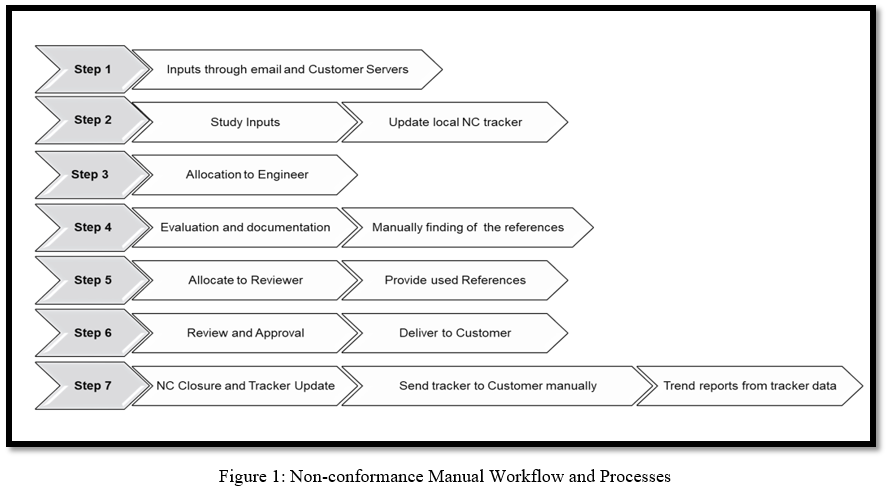
B. Challenges with Manual Workflow and Processes
- Database Management with Excel Trackers: Years of data piling up need to be managed appropriately for future dispositioning and can be challenging for an extended period with unstable excel trackers.
- Finding Acceptance Limits: Acceptance of Non-conformances are dependent on manufacturing drawing limits (also referred to as tolerances or acceptance criteria) which change with its revision updates from time to time. To find the current acceptance limits by referring to previous disposition documents, drawings, and trackers is a laborious manual process.
- Data analysis with Customized Reports: Requirements of customized reports from customers and various stakeholders to analyze Non-conformances is a continuous process. Consolidation of tracker reports in the required format from different teams to analyze the data is a time-consuming process.
- Status Tracking Globally: Customer and global stakeholders feel it difficult to find the status of the Non-conformance progress during the execution process.
- Stakeholder Communication: External and Internal Stakeholder communication with E-mail, calls, and meetings consumes a lot of productive time during dispositioning of Non-conformances.
- Project Management and Project Engineering Activities: Maintaining a lot of trackers for the delivery status, acceptance limits, trend report, Non-conformance classification, and lead time monitoring becomes challenging project engineering activity. Also, several meetings need to be conducted by project engineers between customers, teams, departments, disciplines, and experts to take the feedback and approvals. Finding and allocating the right resource as per previous experience and current loading is also increases the lead time.
- Coordination Between Departments: The sharing of files and communication across disciplines adds a substantial amount of wait time. A project engineer continuously monitors several parallel workflows to ensure that technical data is readily available between teams and reduce the lead time
- Global Database Management: Database management with different trackers across different geographic locations creates confusion between stakeholders during discussions and meetings
- Historical References and Templates: Getting the right reference files like Drawing files, Analysis reports, engineering standard work, Templates, etc. at right time is crucial in Non-conformance disposition. These need continuous checking of available trackers or stakeholders for the file server path.
- Manufacturing Improvement Studies: If the particular type of Non-conformance is occurring often it is necessary to identify the root cause and improve the manufacturing process, tooling or fixtures. This also needs analyzing historical data to figure out the possible root cause and corrective action.
- Manufacturing Tolerance Relaxation Studies: Relaxing the recurring Non-conformance limits is often done as per the historical data to avoid the cost associated with the defects. This step is crucial as it saves a lot of manufacturing and repair costs but needs a detailed analysis with historical data so that quality is not compromised.
Gathering all the listed challenges and requirements for digitization from various stakeholders across geographies required several meetings. Several VSM (Value stream mapping) was performed for all the workflows to identify improvement opportunities. Customers and all the stakeholder's buy-in was taken to avoid any future rework or framework changes. Considering all the gathered challenges, improvement opportunities, and stakeholder requirements the Digital solution framework was developed.
The Digital solution is designed to eliminate the challenges associated with the manual process of Non-conformance workflows as explained earlier. Figure 2 shows the Gates and Features of the Digital solution developed. Data entry, Allocation, Evaluation followed by Review and Approval are classified as the Workflow Gates which control the process of NC execution to customer approval process.
These workflow gates have several features within each gate necessary for the technical and project management activities which will be explained in upcoming sections. Reporting is done with several inbuilt reporting options and also with a Dashboard showing the live status on any Nonconformance.
All the framework and features of these Gates would be explained in the paper to understand its benefits over the convention manual processes. E-mail notifications are an integral part of the portal that triggers at each gate for every important activity to keep the stakeholders informed on progress or alert to close the action pending.

C. Digital Solution Framework
The digital solution framework is in line with the manual process as per Figure 1 but more robust and foolproof with gated reviews and feedback mechanisms as shown in Figure 3. The Digital solution feedback mechanisms work with E-mail notifications and alerts to keep the stakeholders informed all the time. The whole web-based portal is designed to "Analyze-Dispose-Report-Monitor” complete Non-conformance workflows and processes. In addition to the workflow gates, the Portal is enhanced with Dashboard, Reports, and Search gates which optimize the digital solution further to address many more challenges encountered in the manual process as listed earlier. The functionality and features of these gates would be further discussed in the following sections.
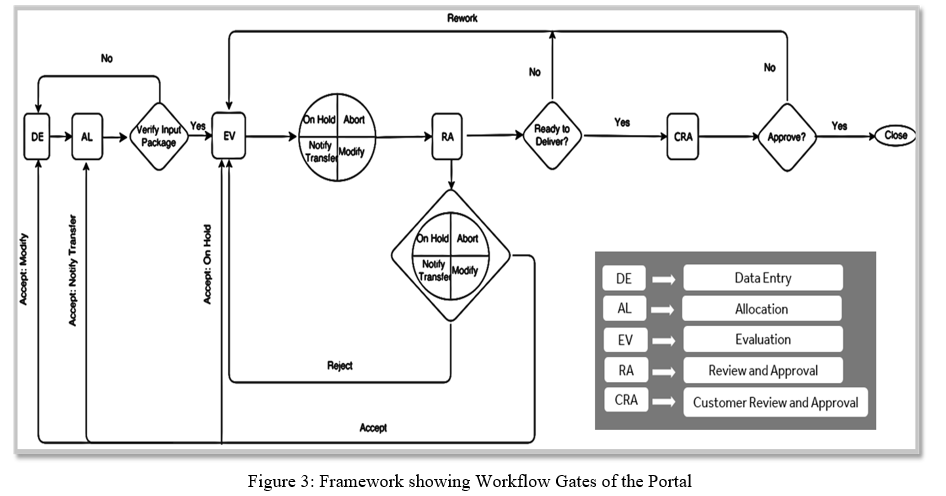
III. RESULTS AND DISCUSSION
By integrating the Digital features into a framework that integrates all phases of project execution with a feedback mechanism, you have an extremely powerful tool. This section will discuss how all of these features work together to support the project's phases and gated review processes, which in this case is Nonconformance workflow management. In addition, we can see how much more efficient Digitization is than the traditional manual approach, as well as the cost savings and the non-tangible benefits associated with Digitalization.
A. Project Execution and Management with Digital Workflow
Workflow gates are designed considering all the Project execution and Project management requirements. As per the Digital workflow framework shown in Figure 3, all the processes are organized and tagged to relevant stakeholders with Gated reviews resulting in reduced lead time. We would now discuss these workflow gates in coming sections to understand the impact of Digital workflow in execution lead time reduction and many other process benefits in project management, monitoring, and control aspects.
B. Organized Digital Workflow with Gated reviews
- Data Entry is the first gate where we feed the Non-conformance data into the empty fields provided in the portal. This data becomes part of the extensive database that we use later as historical data and can be harvested in several ways for rule-based dispositioning, auto allocation of associates, data analysis with trend reports, dynamic search options, and relaxation studies. For some of the recurring Non-conformances, this gate has integrated tools to dispose of directly, in a few cases it auto feeds the required fields from inputs like CMM (Coordinate Measuring Machine) data and even suggest the acceptance criteria from historical data using decision tree models as shown in Figure 4. Integrated tools automatically evaluate and create all the required disposition documents, stack-up analysis, supporting evaluation documents, and checklist to make the complete delivery package without going to further execution gates. Some of the new technologies adopted for a few processes are shown in Figure 4 as flowcharts. Once Data entry is done the Non-conformance moves to the next Allocation step in the workflow as shown in Figure 3.
- Allocation Gate is the next stage after Data Entry is done by the associate to allocate for evaluation (as part of Evaluation Gate explained next) and review (as part of Review and Approval Gate explained in a later section) the Non-conformance. It can be done manually by a lead engineer or can be auto allocated by an algorithm that picks up the most qualified associate by checking his previous history on who executed similar Non-conformance, who is having less workload, and who is available in the particular department. The algorithm applies linear programming to suggest the appropriate associate as per his competency and current availability as shown in Figure 4. Once assigned the engineer needs to verify the package for the inputs and submit it to the next Evaluation gate as per the portal framework in Figure 3.
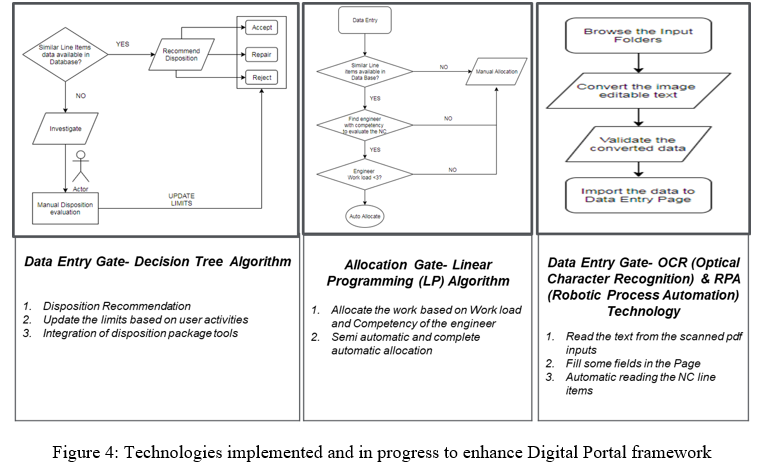
3. Evaluation gate is the next stage wherein the allocated engineer dispositions the Non-conformance with all the available references, integrated tools, and templates provided by the portal which are already tagged to respective Non-conformance as needed. This saves considerable time in terms of searching for references and previous acceptance criteria. The evaluation gate also has a feedback mechanism as shown in the workflow in Figure 3 to Hold, Notify transfer, Abort or Modify before going to Review and approval gate. This feedback would be further reviewed and necessary actions are taken at the next Gate or previous gates to avoid any turnbacks in the final delivery. The received feedback also goes as an E-mail notification to the concerned stakeholders so that no one slips out the alert raised in the portal.
4. Review and Approval Gate is the next level of quality checking where the more senior associate checks the disposition sent from the Evaluation gate and takes the action to either deliver or revert with a similar feedback mechanism as in the Evaluation gate.
5. Customer Review and Approval is the final gate that happens on the customer side from a different geographical location and time zone. Final approval is given by the customer or resends back with necessary feedback in this step.
The explained digitized gated reviews bring up organized workflows with a seamless feedback mechanism that saves so much productive time as compared to manual processes. Feedback mechanism and E-mail notification to the concerned stakeholders keep the communication channels always active at every workflow gate. These gated reviews explained can also be extended and customized to multiple suppliers as per the product supply chain requirement before it reaches the final customer approval. All the gated review live Non-conformance status is also reflected in the dashboard with reprioritization options of Non-conformances given to customers that will be discussed in the next section.
C. Stakeholder Management, Monitoring, and Communication
Monitoring and Control is another aspect of project management to make sure that all the above workflow gates are functioning seamlessly with appropriate feedback and notifications from the stakeholders across the supply chain. This is the bridge that connects the workflows and sets up a roadmap for all stakeholders to optimize the performance with parallel workflows between the teams, disciplines, suppliers, and customers. It also provides the data analytics of all the historical data accumulated over the years in the form of reports for any necessary corrective actions as needed. Compared to manual processes, this digital approach offers high-level error proofing with much greater productivity.
D. Live Dashboards, Prioritization, and Notifications
- The dashboard gives a quantified holistic picture of Non-conformances across different teams which can be further drilled down to categories of Non-conformances reported. It gives detailed matrices showing the recent Non-conformance executed and live status of ongoing Non-conformances in workflow gates along with options to prioritize based on the criticality to avoid any potential shipment delays. The dashboard can extract the data of any specific team of interest as per the duration of Dates picked. Dashboard screen also has alert tabs showing Non-conformances that exceeded the scheduled target dates of delivery, attention required on any Non-conformance which is on hold for a long time in the specific gate, and also overall longer TAT (Turnaround time) Non-conformances. All these options are part of the Dashboard depicted in Figure 5. The whole dashboard is visible across the customers, vendors and global stakeholders to understand Non-conformance live status in advance and reprioritize to optimize productivity and lead time as per the dependencies. It even helps the project manager to check the red flags and take corrective action to clear roadblocks for the team working on assigned Non-conformance.
- The prioritization option in Dashboard is another feature that allows the customer to make the necessary changes in target dates from baseline requirements seamlessly by reprioritizing as per the initiated change request. It alerts all the stakeholders involved in the Non-conformance to realign their deliveries and dependencies to proposed change which makes the process more productive as compared to the old manual process where several communications need to be rolled out to every team in different geographical locations and disciplines. This also eliminates the necessity of several internal and external meetings to confirm reprioritization from the customer, explain the reason behind it to stakeholders and realign to change requests as everything is quite clear from the live dashboard and feedback directly from the customer.
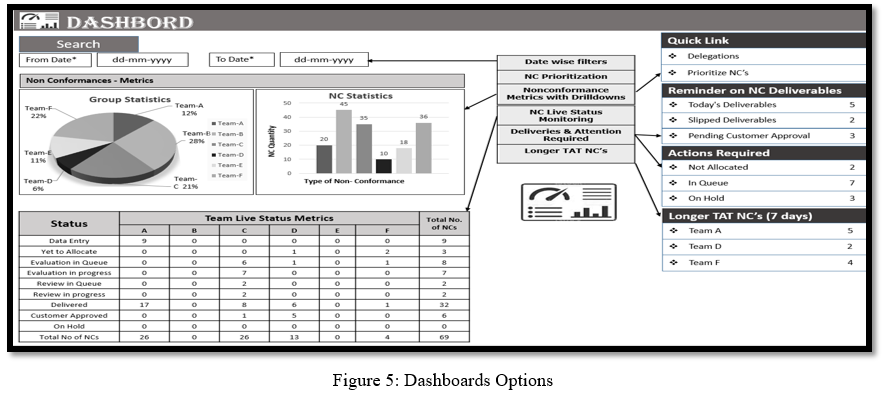
3. Automatic E-mail Notification makes a good amount of difference in productivity as it brings up seamless communication for every process step between stakeholders. Whenever there is a change in any workflow, feedback from stakeholders, delay in deliveries, and reprioritization of Non-conformance from the customer all the necessary stakeholders get E-mail notifications seamlessly as shown in Figure 6. This is simple but of great importance, as it foolproofs all the possible process lapse by a simple E-mail alert unlike in manual processes. These alerts work even the stakeholder is not logged in the portal or occupied with other priority tasks. All such mapping of stakeholder alerts is done in Admin gate in the background which can be edited on a need basis like any change in designation, movement of associate to other teams, or even resignation from the company.
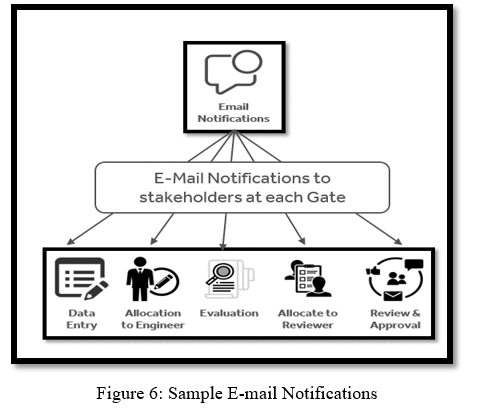
IV. DATA ANALYTICS AND REPORTS
A. Reports, Data analytics, and Dynamic Search Options
Reports are the key future of the Digital solution as it organizes all the data accumulated over the years in various ways for effective Data analysis. All the reports and data analytics also play a vital role in the Project engineering aspect of Non-conformance management. Some reports like Non-conformance tracker, Non-conformance classification, and Itemized reports mainly focus on categorization of the type of Non-conformances for a better understanding of the future possibility of Manufacturing improvements, Tooling change, Engineering design change, and Relaxation studies. Some of the reports are depicted in Figure 7. Even the type of Non-conformances varies from each other in different aspects, one aspect being from where Non-conformances are getting reported like if it’s from Manufacturing shop, Engine assembly shop, Overhaul shop or directly from field operation. The classification gives a good understanding of which phase of product-lifecycle like manufacturing, assembly, operation, or overhaul of the product is adding Non-conformance cost for which the corrective action and studies are to be planned by the project team. Each one has to be addressed with different levels of priorities based on the associated cost which makes reporting such an important tool. Another aspect is more technical like the type of Non-conformance to understand if the deviation from manufacturing drawings dimensions or it's visual damage due to handling. All such classification and reporting in the Digital solution gives good statistical inputs to the engineer for future reference and even helps for project engineers to put a business case for manufacturing or serviceable limit relaxations as per priority to address the reoccurring Non-conformances.
The TAT (Turnaround time) Report assists in quantifying team efficiency by mapping the time taken for each team or discipline in each portal gate. It also helps us to understand where the actual delay is happening in the process as a whole. At times it helps us in Value stream mapping (VSM) of the digital process to identify kaizen (continuous improvement) opportunities and make the Digital solution much better. Non-conformance trend report helps to understand the Non-conformance trends of each team and discuss them in customer and high-level meetings. We can map the users who dispositioned Non-conformances from the login Histories log reports. In some cases, we made some customized reports as per the stakeholder's needs and requirements.
The reporting feature is one of the important aspects of Non-conformance digitization as it eliminates the limitations associated with Excel-based reports which are handled from different geographical locations as part of an earlier manual process.

Dynamic Search options are to extract the Non-conformance data using specific attributes or parameters of any Non-conformance. This works as a quick mapping tool of Non-conformances from the vast historical data with Basic search and advanced search options. This feature is quite useful when we have very limited data or we know a specific thing about the Non-conformance. The user can also apply the elimination method or filters to get the Non-conformance he is trying to map.
B. Accomplishments of Digital Solution
As a summary of all the explained execution, management, monitoring, and control features of the Digital solution can be summarized as shown in Figure 8. It gives a consolidated summary of value additions and accomplishments of the Non-conformance Digitization. Every aspect of Non-conformance workflow: “Analyse-Dispose-Monitor-Report” are captured and digitized to maximize productivity.
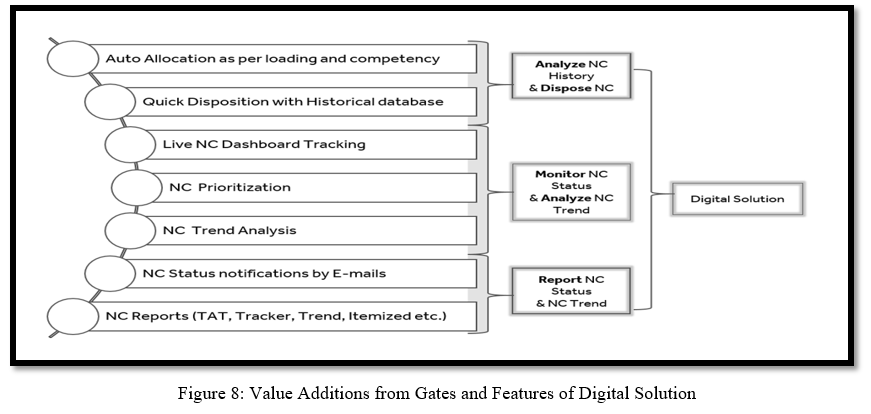
Estimated productive savings are derived by comparing the Manual process with Digital solution processes as shown in Figure 9. It’s been estimated that the current digital solution brings up around 22% of process saving for each Non-conformance for the delivery team. In some teams, the savings numbers even go up to 70% due to integrated tools with the portal which can bypass other gates after Data entry to make the final delivery package. The current exercise of mapping the savings are considering common activities of all delivery teams and also not accounting for all other cost avoidance across the supply chain. When it comes to Non-conformance even an hour is crucial as it can result in a shipment delay of part or module, engine built at assembly shop and then resulting in engine delivery delay. These are the intangible benefits coming from digitization that can be accounted as cost avoidance which can go to even 50-60% depending upon the Non-conformance severity and dependencies. Even on average 22% savings is huge as during production ramp up the team would get hundreds of Non-conformances in a week and each Non-conformance based on its complexity takes a few hours to a few days and even weeks. Considering this conservative 22% percentage also actual savings every year come around 8000 Hrs. for the delivery team alone. The aerospace business also deals with a long supply chain so it can even put the other vendors tagged for lined up manufacturing operations or inspections at stake resulting in business impact.
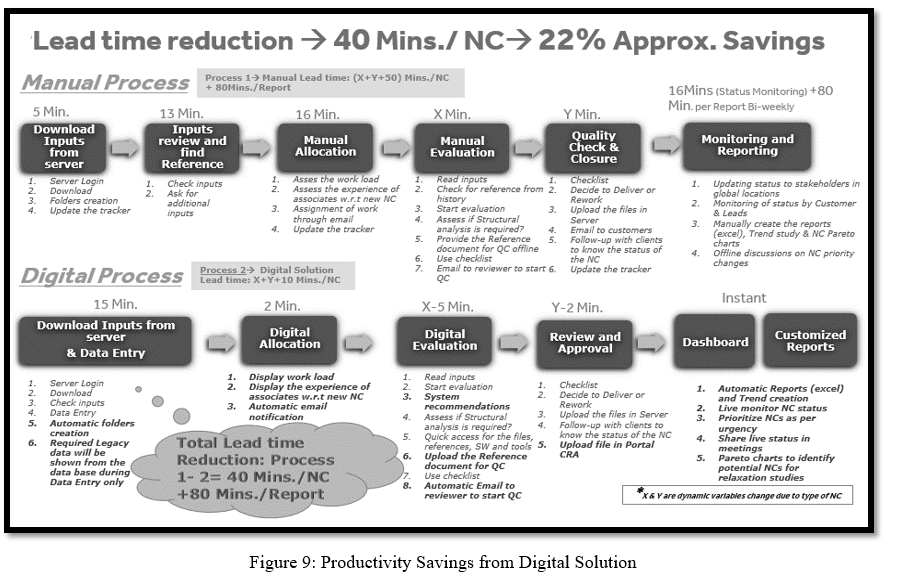
Conclusion
Digitization of the Non-conformance manual workflows and processes is an efficient and productive way to address several challenges in the Aerospace product lifecycle as articulated in the paper. The Digital solution can \"Analyze-Dispose-Monitor-Report” the complete Non-conformance workflows and processes with its digital framework. It has saved Turnaround time (TAT) and increased overall process Productivity by at least 22% for the delivery team on the majority of Non-conformance reported every year as compared to the conventional manual approach. Despite this tangible benefit, the non-tangible benefits of Digitized project management features explained in the paper are higher due to cost avoidance or indirect savings to customers from avoiding potential shipment delays, scrapping of parts, breaking commitments, and goodwill loss across a supply chain. Also, the other part of saving comes from the accumulated and organized digital data from the Digital solution used for relaxation or manufacturing studies in eliminating the future Non-conformances by performing data analysis. This part of savings can be considered as another cost avoidance or a preventive step to avoid most recurring Non-conformances in the future. One more advantage of this Digital solution is its framework scalability possibilities to other Non-Aerospace product lifecycle or integration feasibility with several suppliers\' ERP (Enterprise Resource Planning) systems across the supply chain. It monitors and connects stakeholders with seamless communication channels as explained and brings up customer satisfaction at all levels in the supply chain. The developed Digital solution also gives additional time for the engineers to put their efforts into innovation rather than spending productive engineering time in laborious repetitive manual work. The future is all digital to take productivity to next level so we are looking at every aspect to harvest from our existing manual processes. The digital solution model discussed can be applied not just in aerospace but also to other product industries as fundamentally Non-conformance is a common problem associated with any Product life cycle. A. Scope for Future Study To digitize manual workflows, and processes, most of the algorithms used in the current Digital solution are based on Rule-based programming, Decision trees, and RPA (Robotic Process Automation) software such as UI Path, Optical Character Recognition (OCR), and integrating desktop tools with in house APIs (Application Programming Interface) development. As a scope of `future study, we are still working on recent technologies like ML (Machine learning) and AI (Artificial intelligence) models to further harvest the data much smartly with even less manual efforts. Application of AI and ML can be rewarding as the historical data speaks a lot about the manufacturing, tooling, and engineering process deviations. It can even alert the engineer by continuously monitoring the baseline requirements from drawings or process capability requirements and even suggest preventive actions before any Non-conformance comes in reality which can be a game-changer. Digitization is a continuous improvement process so we need to keep looking for recent technologies and the possibility to use them efficiently through Digital framework or scale further to leverage the productivity to the next level.
References
[1] Norzima Zulkifli, Kausalyah Thevendram, “IMPROVISATION OF NON-CONFORMANCE MANAGEMENT IN A SMALL AEROSPACE MANUFACTURING INDUSTRY,” Journal of Mechanical Engineering Research and Developments (JMERD)42(5):190-193, 2019: https://www.researchgate.net/publication/335982370_IMPROVISATION_OF_NON-CONFORMANCE_MANAGEMENT_IN_A_SMALL_AEROSPACE_MANUFACTURING_INDUSTRY [2] Stainow, C. 2011. The Importance of Non-Conformance Management. Retrieved from Lennox Hill Quality Assurance Solution: https://www.isotracker.com/blog/the-importance-of-non-conformance-management
Copyright
Copyright © 2022 Subhash Gopi, Dicson Joshua, Venkata Satish Valluri. This is an open access article distributed under the Creative Commons Attribution License, which permits unrestricted use, distribution, and reproduction in any medium, provided the original work is properly cited.

Download Paper
Paper Id : IJRASET40258
Publish Date : 2022-02-07
ISSN : 2321-9653
Publisher Name : IJRASET
DOI Link : Click Here
 Submit Paper Online
Submit Paper Online

